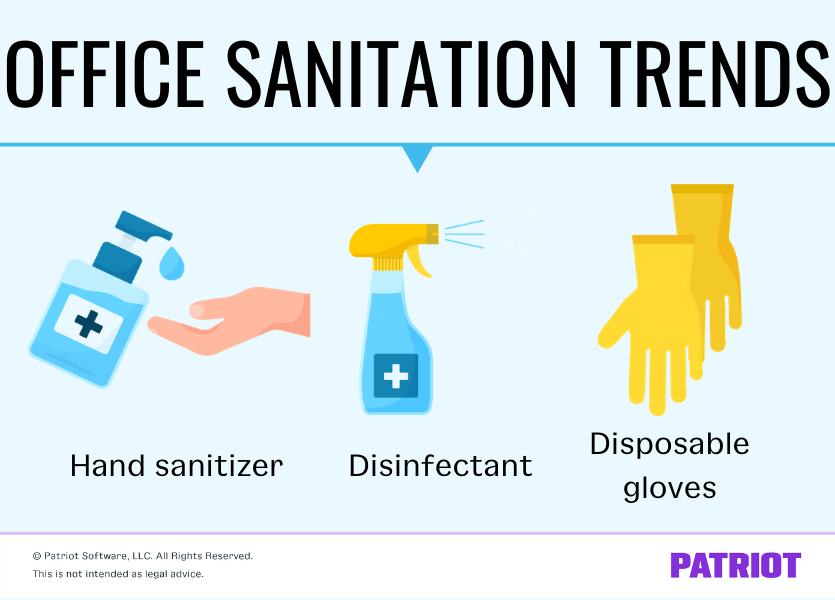All in all, 2020 was a doozy of a year. The new decade brought with it a number of new workplace trends for many employers, including new sanitary needs, social distancing, and even a transition to work-from-home options. Here’s how you can use workplace trends to remain competitive.
Workplace trends
Where and how employees work has drastically changed. You might have grown your office space, moved locations, or gone entirely remote. So, how have these changes impacted businesses?
New types of workplace trends include:
- Office trends
- Technology trends
- Health trends
Office trends
Are you still in the office? There are a few office trends to keep in mind to maximize the space available. Here are some of the options you have to make your office space modern and functional.
Hot desking
No, we don’t mean turning up the heat. Instead, hot desking allows your employees to share desk space without overlap.
For example, your first-shift workers can leave at 4:00 p.m. as the second-shift arrives at 4:00 p.m. Or, employees who work remotely Mondays, Wednesdays, and Fridays share desks with employees who work remotely Tuesdays and Thursdays.
Hot desking cuts down costs for you by reducing the number of desks and chairs you need to purchase. You can also arrange for each workspace to share equipment, lessening the cost further. This, in turn, can make it so that you rent less office space and save even more.
If you do opt for hot desking, be sure to properly sanitize everything that’s used between employees (which we’ll get to later).
Desk and chair alternatives
Employee comfort is more than just something nice to consider—it can actually improve productivity and lessen business costs. The Occupational Safety and Health Administration (OSHA) estimates that $1 of every $3 spent on workers’ compensation is a result of poor ergonomic protection.
So, how can you save yourself some money and protect your employees? Here are a few options:
- Standing desks
- Adjustable desktop bases
- Ergonomic chairs with
- Lumbar support
- Overall comfort
- Adjustable seat depth and height (especially if you’re hot desking!)
You can find options that look like standard computer desk chairs, stools, or even exercise balls. Desk chair alternatives are increasingly popular (77% of employees think ergonomics is important) and can lead to long-term savings.
Work from home
Perhaps the biggest workplace trend to come out of 2020 was the opportunity to work from home. Many businesses temporarily transitioned to home offices and online meetings with the help of tools like Zoom. One study shows that 60% of employees who currently work from home will not return to the office until they decide it feels safe. A number of businesses have also adopted complete work-from-home policies.
In some cases, work from home is done on a hybrid basis. Some employees work from home half the time and in the office the other half, while other employees work the opposite schedule. This reduces the number of people in-office to allow for more social distancing and increased health and safety.
Technology trends
One of the top workplace trends to keep in mind revolves around the technology you use. The cyber-world is here to stay, and making sure your employees remain connected and secure is important. So, how are workplace trends shifting with technology? Here are a couple digital workplace trends to keep in mind.
Virtual meetings
Employees are now more isolated than ever before. To combat that loneliness and ensure that meetings still take place, many companies have moved to online video conferencing (e.g., Google Hangouts Meet). Or, they use communication tools like Slack to keep in contact throughout the workday.
Technology use has grown exponentially, showing that this trend is here to stay, even as stay-at-home orders and work-from-home options ease. This brings up the next point—keeping your cyber interactions secure.
Cybersecurity
Whether you’re working from home or out of a centralized office space, you need to keep data and information secure. Working from home, however, could come with additional, potential security concerns. One poll shows that 61% of IT and security professionals are concerned about the potential security risks of working from home.
Important cybersecurity trends include:
- Implementing remote desktop protocols (RDPs)
- Using virtual private networks (VPNs)
- Training employees on the importance of malware and phishing awareness
- Creating remote work policies and procedures
Evaluate if you need to train employees on cybersecurity. You may consider training sessions between your IT staff (if applicable) and other employees to ensure everyone is up-to-speed on their security knowledge.
Health and the workplace
If there is one thing that 2020 impacted, it is our awareness of health and safety. And, no, we don’t just mean OSHA standards.
Thanks to COVID-19, we are suddenly aware of how close we sit to each other, the frequency that common spaces are cleaned, and if team meetings can be handled via email to maintain social distancing. How are workplace trends influenced by health and safety concerns?
Cleanliness
Pre-2020, office cleanliness was important. Now, it’s vital to the health and safety of your employees.
Consider stocking the following in your office:
- Hand sanitizer
- Disinfectant wipes
- Disposable gloves

And, be sure to have other forms of personal protective equipment (e.g., masks) available for your employees.
You may consider hiring an outside sanitation company to come into your office and clean frequently for you.
Paid sick leave
Paid sick leave is not just a trend. Depending on your state, providing paid sick leave might be the law. If paid sick leave laws by state don’t apply to you, you may still consider offering it.
Sick pay is desirable to employees and beneficial to your company. But, how is paying an employee to take time off work when sick supposed to benefit? Here’s how:
- Less employee turnover
- More productive employees
- Reduced risk of illness among all employees
- Lowered health costs
- Ability to remain competitive when seeking new talent
One study found that paid sick leave can save employers up to $1.8 billion annually just by reducing the spread of illnesses like the flu. Yes, you read that right—billion with a B. And, the Bureau of Labor Statistics (BLS) shows that roughly 75% of all businesses in the U.S. offer paid sick leave, which means that you remain competitive to potential employees and save money.
Flexible work schedules
A flexible work schedule is one workplace trend that was once just a perk. Now, employees may need the flexibility in their day to work different hours. For example, employees with children may need the option to work from home or work a varied schedule until schools open (and remain opened).
Offering a flexible work schedule to your employees can:
- Boost morale
- Increase productivity
- Reduce stress
- Prevent burnout
Flexible schedules also provide the work-life balance so many workers seek when looking for a new job.
Modern workplace trends are drastically different than those of yesteryear. No matter how you approach them, you have plenty of options on how to grow your business and stay competitive.
This is not intended as legal advice; for more information, please click here.



